To capture motorsports magic from above, start by choosing a drone with high speed, advanced stabilization, and a 4K camera. Master your camera settings, using fast shutter speeds and appropriate aperture for crisp images. Plan your shots strategically by scouting locations and studying race schedules. Always follow safety regulations, staying within designated areas and maintaining visual line of sight. After shooting, enhance your footage through post-processing, adjusting exposure and applying selective edits. These pro tips will elevate your aerial motorsports photography, but there's more to explore in the world of high-octane imagery from the skies.
Choose the Right Drone
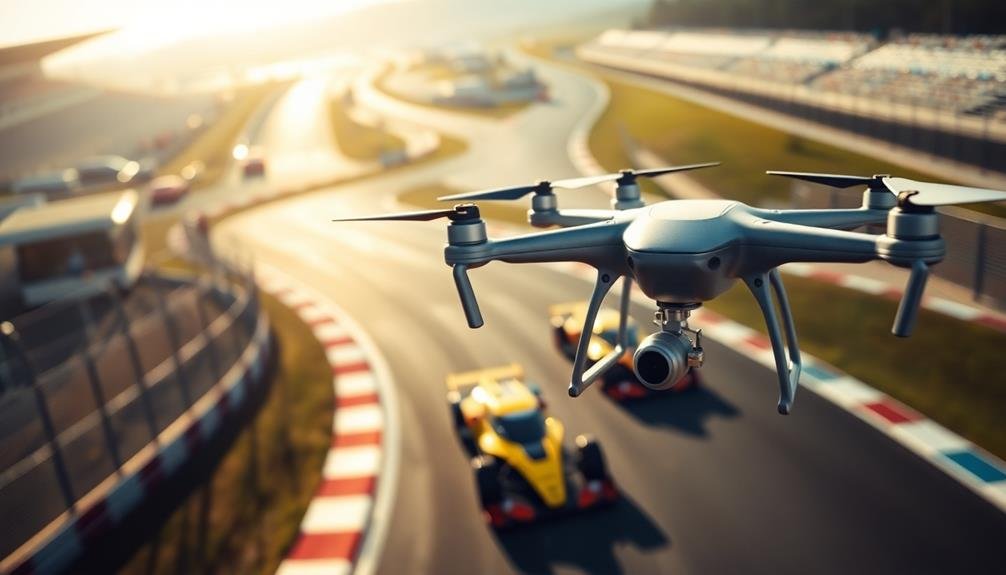
When it comes to capturing motorsports magic, your drone choice can make or break your footage. You'll need a model that combines speed, stability, and high-quality imaging capabilities. Look for drones with top speeds of at least 40 mph to keep up with racing action.
Opt for models with advanced stabilization systems to guarantee smooth footage, even in windy conditions. Camera quality is vital. Choose a drone with at least a 4K camera and a 1-inch sensor for crisp, detailed shots.
Consider models with adjustable frame rates, allowing you to capture slow-motion footage of high-speed maneuvers. Don't overlook battery life; you'll want a drone that can stay airborne for at least 25 minutes to cover extended race segments.
Obstacle avoidance technology is essential for maneuvering through complex racing environments safely. Look for drones with omnidirectional sensors to detect and avoid potential collisions.
Master Your Camera Settings
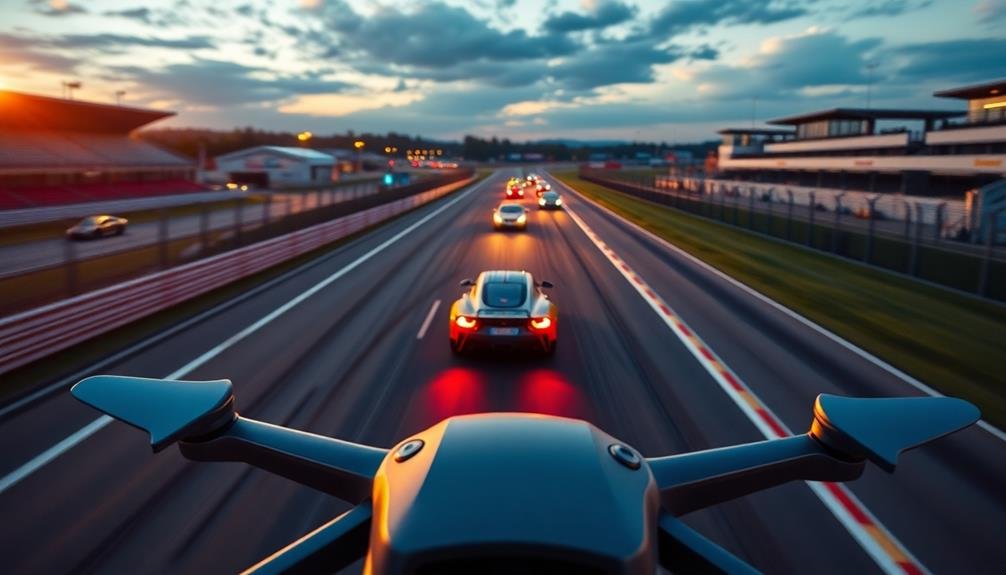
Three key camera settings are essential for capturing motorsports magic: shutter speed, aperture, and ISO. You'll need to master these to freeze the action and create stunning aerial shots.
For most motorsports, you'll want a fast shutter speed of at least 1/1000th of a second to capture crisp images of speeding vehicles. Set your aperture between f/4 and f/8 to balance depth of field with light intake. Adjust your ISO to maintain proper exposure, typically between 100 and 800 depending on lighting conditions.
Experiment with different combinations to find what works best for your specific drone and racing environment. Don't forget to shoot in RAW format for maximum flexibility in post-processing.
Here are four quick tips to enhance your motorsports drone photography:
- Use burst mode to increase your chances of capturing the perfect moment
- Enable auto-focus tracking to keep moving subjects sharp
- Utilize neutral density filters in bright conditions to maintain slower shutter speeds
- Practice panning techniques to create a sense of motion in your shots
Plan Your Shots Strategically
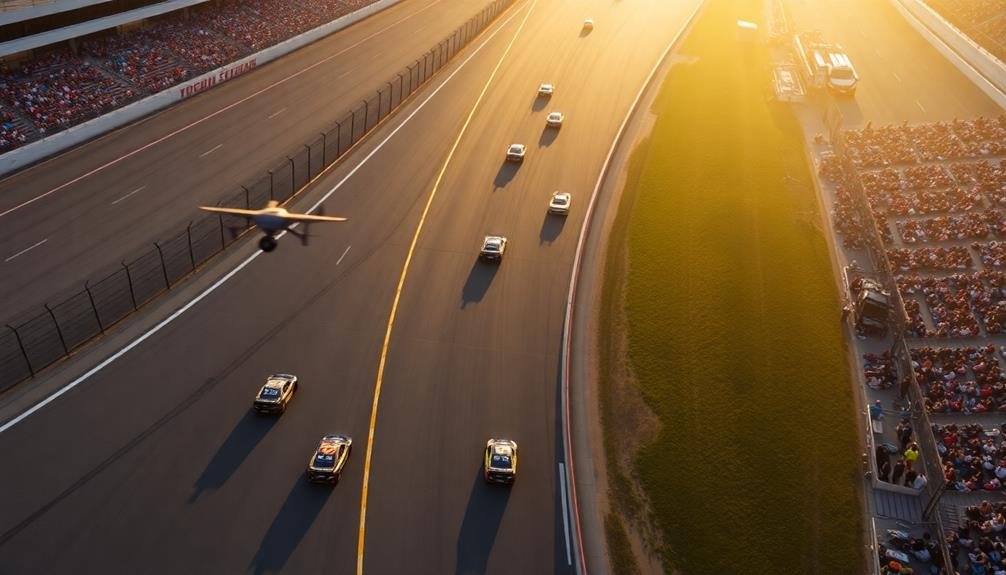
Now that you've mastered your camera settings, it's time to focus on strategic shot planning. Start by researching the track layout and identifying key vantage points. Look for areas that offer unique perspectives, such as tight turns, long straightaways, or elevation changes.
Consider the direction of sunlight throughout the day to avoid harsh shadows or backlit subjects. Arrive early to scout locations and set up your equipment. Prioritize safety by following all venue guidelines and staying within designated areas.
Anticipate the action by studying race schedules and understanding different motorsport disciplines. This knowledge will help you predict where exciting moments are likely to occur.
Vary your shots to create a diverse portfolio. Capture wide-angle views of the entire track, as well as close-ups of drivers and vehicles. Experiment with different angles, including low to the ground or high overhead perspectives.
Use natural framing elements like barriers or trackside structures to add depth to your compositions. Don't forget to document the atmosphere surrounding the event. Capture images of the pit crews, spectators, and pre-race preparations to tell a complete story of the motorsports experience.
Follow Safety Regulations
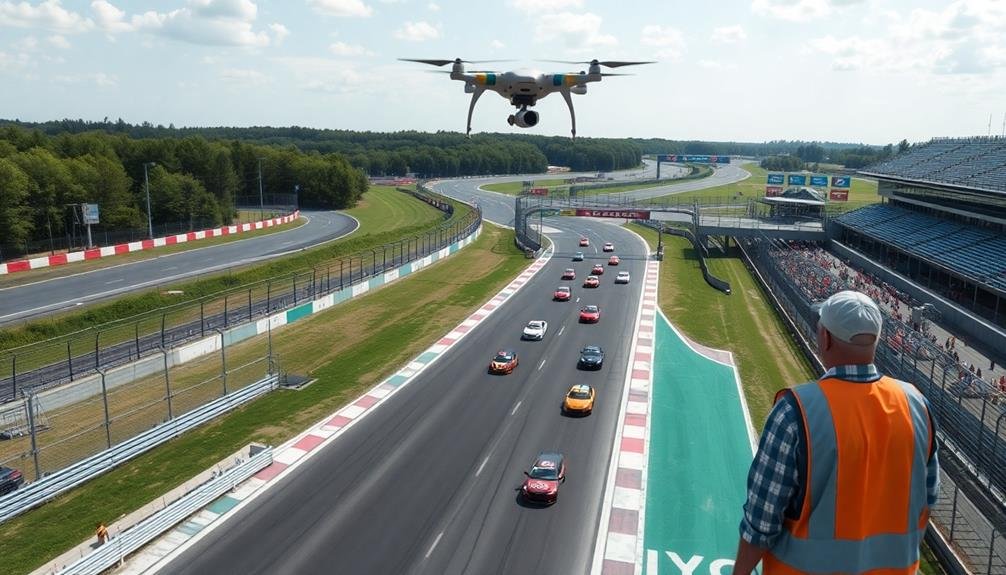
Safety should always be your top priority when photographing motorsports events. Adhering to safety regulations isn't just about protecting yourself; it's also vital for the well-being of drivers, crew members, and spectators.
Before you start shooting, familiarize yourself with the event's specific safety guidelines and follow them strictly. Most racetracks have designated areas for photographers, so stay within these zones at all times.
When using drones for aerial shots, you'll need to comply with additional regulations. Verify that you're licensed to operate a drone commercially and that you've registered your equipment with the appropriate authorities. Always maintain visual line of sight with your drone and keep it away from race areas and spectator zones.
Here are four essential safety tips to remember:
- Wear high-visibility clothing to guarantee you're easily seen by drivers and officials.
- Use proper ear protection to guard against loud engine noise.
- Stay alert and be prepared to move quickly if necessary.
- Never cross barriers or enter restricted areas without proper authorization.
Post-Processing for Maximum Impact
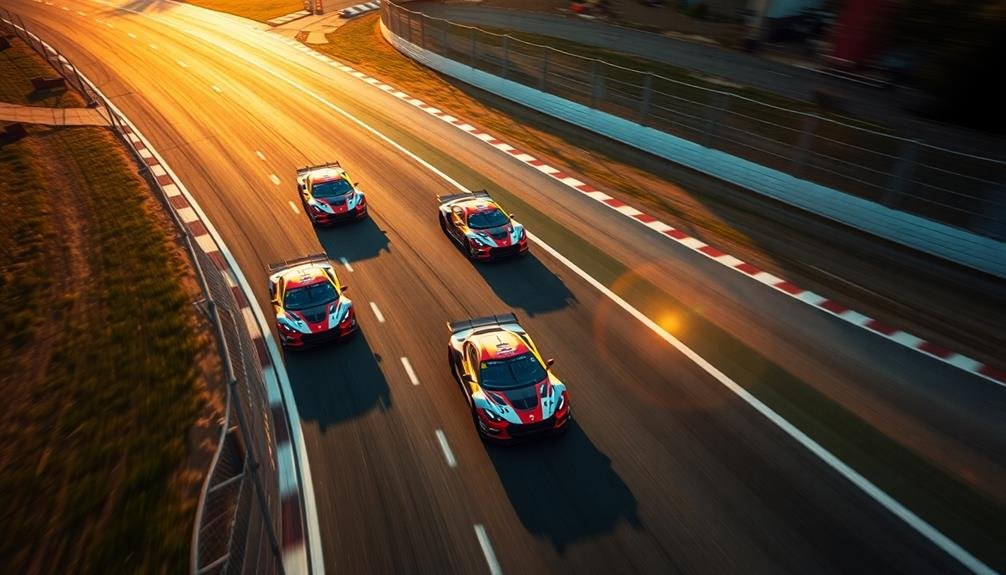
After capturing your motorsports images, the real magic happens in post-processing. Start by importing your photos into your preferred editing software and organize them for easy access.
Adjust the exposure, contrast, and white balance to enhance the overall look of your images. Pay special attention to the highlights and shadows, ensuring you don't lose detail in either extreme.
Crop your images to improve composition and remove any distracting elements. Use the straighten tool to correct any tilted horizons.
Apply sharpening to bring out the details in the vehicles and track, but be careful not to overdo it. Reduce noise if necessary, especially in low-light shots.
Consider using selective adjustments to draw attention to specific areas of the image. Boost the vibrance of team colors or emphasize the motion blur of spinning wheels.
Don't forget to remove any sensor dust spots or minor imperfections.
Frequently Asked Questions
How Do I Get Permission to Fly a Drone at Motorsports Events?
You'll need to contact the event organizers and track management for permission. They'll likely require proof of your drone license, insurance, and flight plan. Be prepared to follow strict guidelines and safety protocols during the event.
What's the Best Time of Day to Capture Aerial Motorsports Footage?
You'll get the best aerial motorsports footage during the "golden hour" – just after sunrise or before sunset. The low, warm light adds drama and depth to your shots. Midday can work for bright, high-contrast images too.
How Can I Minimize Propeller Noise in My Drone Footage?
You can minimize propeller noise in your drone footage by using balanced propellers, flying higher, avoiding sudden movements, and using a wind muffler. Additionally, you'll want to choose quieter drones and consider post-production noise reduction techniques.
Are There Specific Insurance Requirements for Drone Use in Motorsports Photography?
You'll need specialized drone insurance for motorsports photography. It should cover liability, equipment damage, and potential track interruptions. Check with event organizers for specific requirements, as they may demand higher coverage limits than standard policies.
What's the Ideal Flying Altitude for Capturing Motorsports Action From Above?
You'll want to fly between 100-300 feet for ideal motorsports shots. This altitude gives you a broad view while maintaining detail. Don't forget to check local regulations and track rules before taking flight.
In Summary
You're now equipped to capture breathtaking aerial motorsports footage. Remember, it's all about choosing the right drone, mastering your settings, and planning strategically. Don't forget to prioritize safety and follow regulations. Finally, polish your shots in post-processing to truly make them shine. With these tips in your arsenal, you'll be creating stunning aerial motorsports content that'll leave your audience in awe. So get out there and start shooting!

As educators and advocates for responsible drone use, we’re committed to sharing our knowledge and expertise with aspiring aerial photographers.
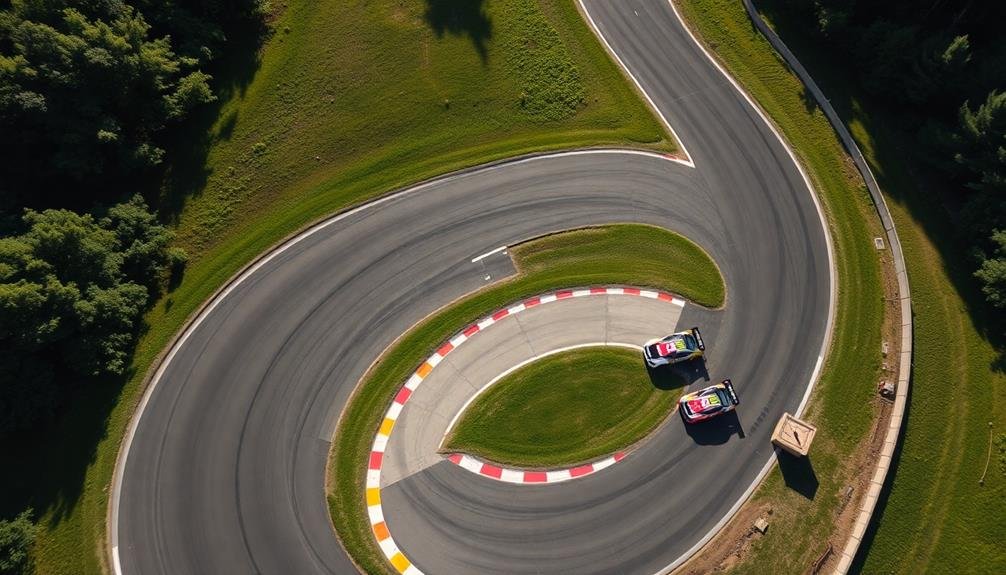



Leave a Reply